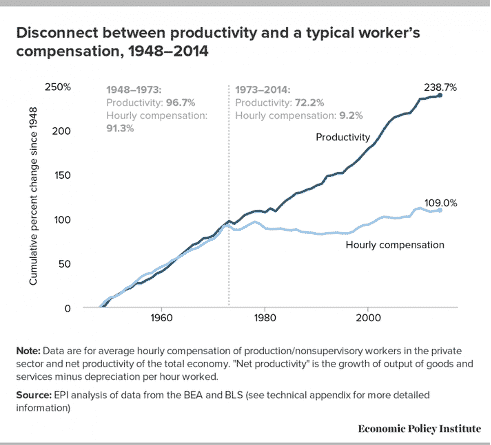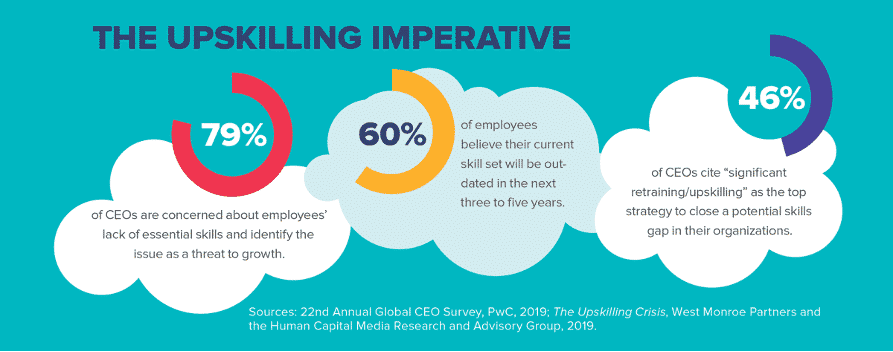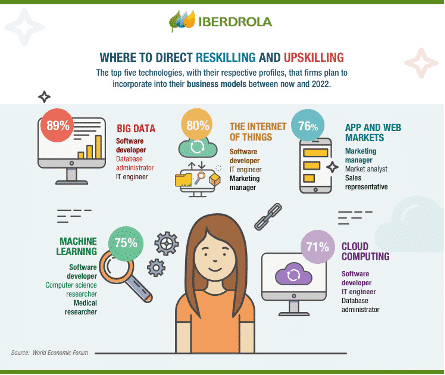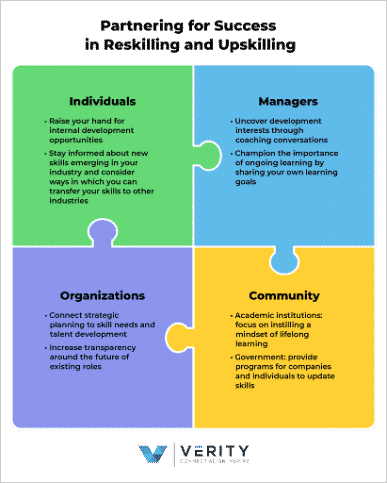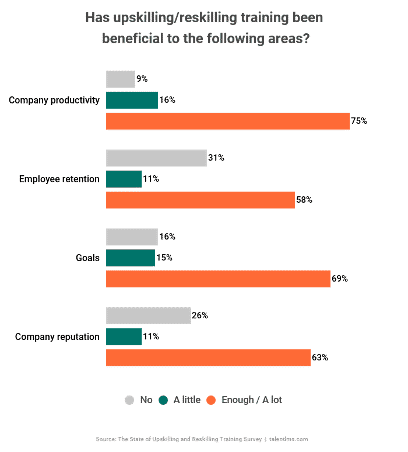Upskilling is the latest workplace trend—and it’s one you should follow, because it’s revolutionary. Business owners are always looking for new strategies to increase workplace productivity, creativity, employee loyalty, and overall company growth. Upskilling could be the answer for employers and employees alike. So, why is it necessary?
The Skills Gap
Most Americans enjoyed speedy wage growth between 1945 and 1979, thanks to the thriving U.S. economy. Unfortunately, she’s a fickle beast—the economy, that is. Since 1980 there’s been a rapid and sharp decline in wage growth and equality. Low-to-mid level wage workers have been hit the hardest.
A study by the International Monetary Fund, Causes and Consequences of Inequality: A Global Perspective, claims that widening income inequality is the defining challenge of the present day. Their analysis concludes that technological progress has seen a rise in the skill premium, while the decline of various labor market institutions has left many workers floundering. It’s a big problem, as income inequality has serious implications for macroeconomic stability and growth.
So, what does this have to do with the skills gap? Well, the increase in wage inequality is largely caused by the increase in skills inequality. In 2017, John Streur (President and CEO of Calvert Research and Management) and George Serafeim (Charles M. Williams Professor of Business Administration at Harvard Business School) collaborated on an article for the Harvard Business Review, entitled Stop Waiting for Governments to Close the Skills Gap. The two experts surmise that the wages and overall conditions of workers will only improve if we align workers’ interests with shareholders’ interests. That way, companies will invest in workers’ well-being as a business strategy in anticipation of enhanced financial results.
So, how can companies best enhance their financial results (and serve their employees) in a speedily mutating technological and economic environment (while also, as a bonus, aiding in stabilizing the overall United States economy)? The answer is simple—upskilling.
What is Upskilling?
Two words: continuous learning. Technology advances rapidly, it only makes sense that companies and employees must rapidly and consistently advance their technical knowledge and skill sets in order to keep up with it. As job requirements shift and possession of new technological knowledge and abilities becomes more necessary, companies must either hire new workers who possess the skills they need or figure out sustainable ways to incorporate continuous learning practices into their current workforce.
According to a research report entitled Competing for Talent in the Digital Age from CEB (Corporate Executive Board, an international best practice insights and technology company), every single American industry is under pressure to find and hire skilled workers. Adding more pressure, the median time that it takes organizations to fill positions increased by six weeks between 2010 and 2017.
The research examined data from CEB’s Talentneuron platform on the 2016 job postings from the S&P 100 companies. Of the 9,000 jobs posted (90% of which were being actively recruited for), 39% of the job posting activity was oriented around only 29 jobs. So, what skills are companies looking for that many prospective employees so drastically lack? Digital skills, mostly, and the capacity to adapt to their changeability. Companies are looking for workers with the ability to develop and implement digital technologies in the workplace (with demand highest for those with the complex digital skills needed to create new technologies such as programming languages.
Here is where it’s important for companies to focus on upskilling as a core strategy–what if companies stopped looking for workers with these extensive, complex, specific skill sets, and instead started facilitating training programs in which they taught these skills to the employees they already have?
Hiring new workers takes time and money—a lot of it. This is especially true if companies are hiring new employees in an effort to keep up with advances in technology. Companies would never stop hiring—they’d spend more time hiring then they spend producing actual products or services. Plus, it’s difficult to cultivate a comfortable workplace environment full of loyal employees if employees are constantly being let go or fired for changes in the economic and/or technical landscape that are not their fault and which they have no control over.
Companies can save money and magnify employee satisfaction and loyalty by aiding their workers in strengthening their current skill sets and gaining new skills to add to them, instead of pouring time and money down the river hiring employees whose own skill sets might be rendered inadequate or even obsolete within a year or two.
Employees in the modern workforce expect more from their employers. These days fair pay, and a pleasant workplace environment are just the baseline for what employees expect. Employee perks are increasingly important, and if companies are looking to hire the most competitive applicants, they need to make sure their perks game is on par with those of their peers. From paid time off and comprehensive, affordable healthcare to cushy office spaces with state-of-the-art espresso machines and hip abstract art hanging on the walls, employers are doing everything they can to make sure their workers feel valued and enthusiastic about doing their best work.
COVID-19 has quickly shifted and put into greater perspective what employees actually value from their employers. And, it turns out the pre-pandemic perks don’t hold up as well as some main-stay employee priorities like personal development and career growth. Providing upskill training opportunities is an extraordinarily efficient and effective way to demonstrate to employees that their employer cares about their well-being and professional development, as well as their future at the company. Now that more and more companies are jumping on the upskilling bandwagon, the practice is becoming less of a perk and more of an expectation.
What exactly is upskilling, and what does it look like? Upskilling essentially consists of company-sponsored employee training programs—the entire process of equipping employees with new skills that will aid them not only in their current growth, but also, often, their professional development. Because this kind of training is meant to be ongoing, companies that invest in upskilling are able to consistently and sustainably become more competitive on a financial level as their employees become more competitive and valuable components of the workforce. Business best practices are always changing, and a “best practice” today might look more like a “woefully inadequate practice” tomorrow.
How to Benefit from Upskilling
Why spend time and money recruiting top talent when you can spend markedly less time and money turning your current employees into top talent? Today’s employees expect growth opportunities, and upskilling has been proven to boost performance, morale, motivation, and overall employee satisfaction. So, how can companies effectively implement upskilling strategies, and how can they ensure that they (and, both causationally and correlationally, their employees) benefit?
Stefanio Bellasio, the CEO of Cloud Academy (an enterprise-training platform that offers digital skills training to organizations), advocates for a data-driven approach. Given the significant problem of the tech talent gap especially, it’s important for companies to use nuanced data in order to define the specific job roles, skills, and technologies needed to compete. Training, Bellasio says, should be goal-driven, because when training is framed as a benefit or a should-do, employees often don’t complete it at all. Specificity is essential—when companies emphasize tangible, actionable skills and outcomes and implement mandatory training to achieve those outcomes, employees are far more engaged and far more likely to successfully learn the necessary skills.
Companies should create comprehensive upskilling programs that are tailored to enhance the training and development of their specific organizations. They need to examine themselves closely and ask questions: Volume training vs. one-on-one training? Should training be conducted by internal teams, or with external organizations? What form should learning take—should it be in-person or virtual? How can companies ensure that no employee is left behind or prevented from meeting their goals or enhancing their own skill sets, for the sake of the employee and the company? There are plenty of details to iron out in order to facilitate a successful training program, as training should be designed with each individual employee’s role, current skill set, and potential in mind.
Some employees will need encouragement to get everything they can out of the program, and financial incentive is widely considered to work for most individuals, but it has its limitations. Getting results from a learning and development program isn’t as simple as it seems, despite the obvious benefits to employees. In an organization of 1,000, only 30% of employees or fewer will show interest in upskilling, while others may perceive upskilling as extra work. This is a problem, as motivation is essential to employees’ productivity and quality of work.
With this in mind, some companies provide a 2-3% pay raise upon completion of successful upskilling. However, financial incentives have been proven to sometimes be detrimental. A workforce might become highly certified as employees rush to complete trainings in order to receive more money, but actual commitment to learning and growing may be lacking. In order to address this issue, some companies, like Tata Projects, have done away with financial incentives for learning entirely. Tata’s formal policy requires the attainment of certification and clear improvement in performance. In order to progress within the organization (and therefore enjoy salary increases) employees must first acquire certification of having undergone a learning and development program in order to upskill, and then they must demonstrably deliver on performance before they can rise through the ranks. Many companies are realizing that stand-alone financial incentives for upskilling are not enough—in order for companies to successfully upskill their employees, they must combine financial incentive with recognition and opportunity.
The Cost of Ignoring the Importance of Upskilling
Oh, you’ll pay if development programs don’t start closing the skills gap. It’s critical that everyone, everywhere be prepared for (and hopefully enthusiastic about) the digital world. The mutability and advancement of technology necessitates a global upskilling effort—effective immediately. The ultimatum is clear: incentivize employees to successfully upskill and ensure that no employees are left behind, or be left behind.
Upskilling isn’t just about learning to use a new programming language or additional technology—all technologies will eventually be obsolete, whether that be in six months or ten years. True upskilling means teaching people how to think within, respond to, and rapidly adapt to a morphing technological environment in a way that’s sustainable over time—in other words, employees need to learn how to be constantly learning. Again: continuous learning. Most of the time, this means that employees need to understand the basics of data analytics, artificial intelligence, and other technologies relevant to most modern industries.
Millions of companies are wasting time and losing money trying to replace employees with employees they’ll need to replace sooner or later with other employees whom they’ll also eventually replace. That’s money and time, over and over, needlessly squandered. Meanwhile, research from PwC shows that within the next ten years, one in every three jobs will either be severely disrupted or disappear due to technological change. PwC postulates that this could affect half of low-skilled jobs and a third of semi-skilled jobs.
Companies are missing out on this lost workforce—with painfully expensive consequences. Failure to upskill one’s employees will result in exorbitant loss in growth and economic prosperity for individual organizations—and, of course, for our economy overall.
Want to talk about how Quanthub can help your company build or improve upskilling efforts in 2021?
